The Need for Government Intervention in Australian Agriculture Sector
VerifiedAdded on 2022/10/15
|10
|2634
|498
Report
AI Summary
This report critically examines the necessity of government intervention in the agricultural sector of Australia. It begins by highlighting the significant contribution of the agricultural industry to Australia's economy, emphasizing its role in exports and its vulnerability to environmental factors such as climate change and water scarcity. The report analyzes various research papers that explore the impacts of climate change, government policies, and market dynamics on agricultural production. Key findings indicate that climatic variations lead to a decline in agrarian product supply, increasing domestic prices and decreasing export shares. The report strongly suggests that the Australian government should continue intervening to mitigate the adverse effects of these challenges, emphasizing the need for innovative strategies, policy implementation, and financial support to stabilize the sector and support farmers. The analysis covers aspects like conservation, climate change integration, market distortions, and the role of networks, providing a comprehensive overview of the challenges and potential solutions within the Australian agricultural landscape.
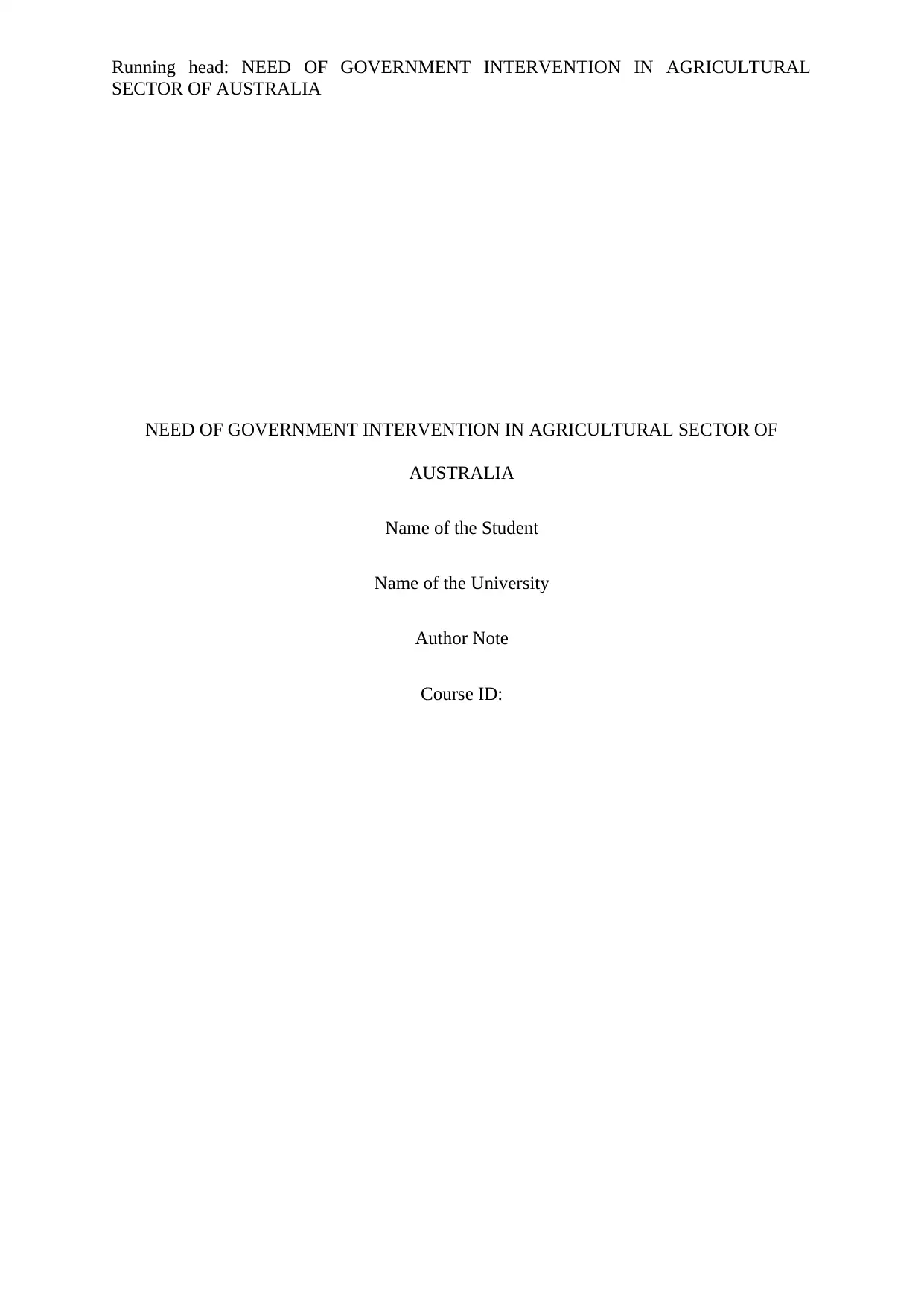
Running head: NEED OF GOVERNMENT INTERVENTION IN AGRICULTURAL
SECTOR OF AUSTRALIA
NEED OF GOVERNMENT INTERVENTION IN AGRICULTURAL SECTOR OF
AUSTRALIA
Name of the Student
Name of the University
Author Note
Course ID:
SECTOR OF AUSTRALIA
NEED OF GOVERNMENT INTERVENTION IN AGRICULTURAL SECTOR OF
AUSTRALIA
Name of the Student
Name of the University
Author Note
Course ID:
Paraphrase This Document
Need a fresh take? Get an instant paraphrase of this document with our AI Paraphraser
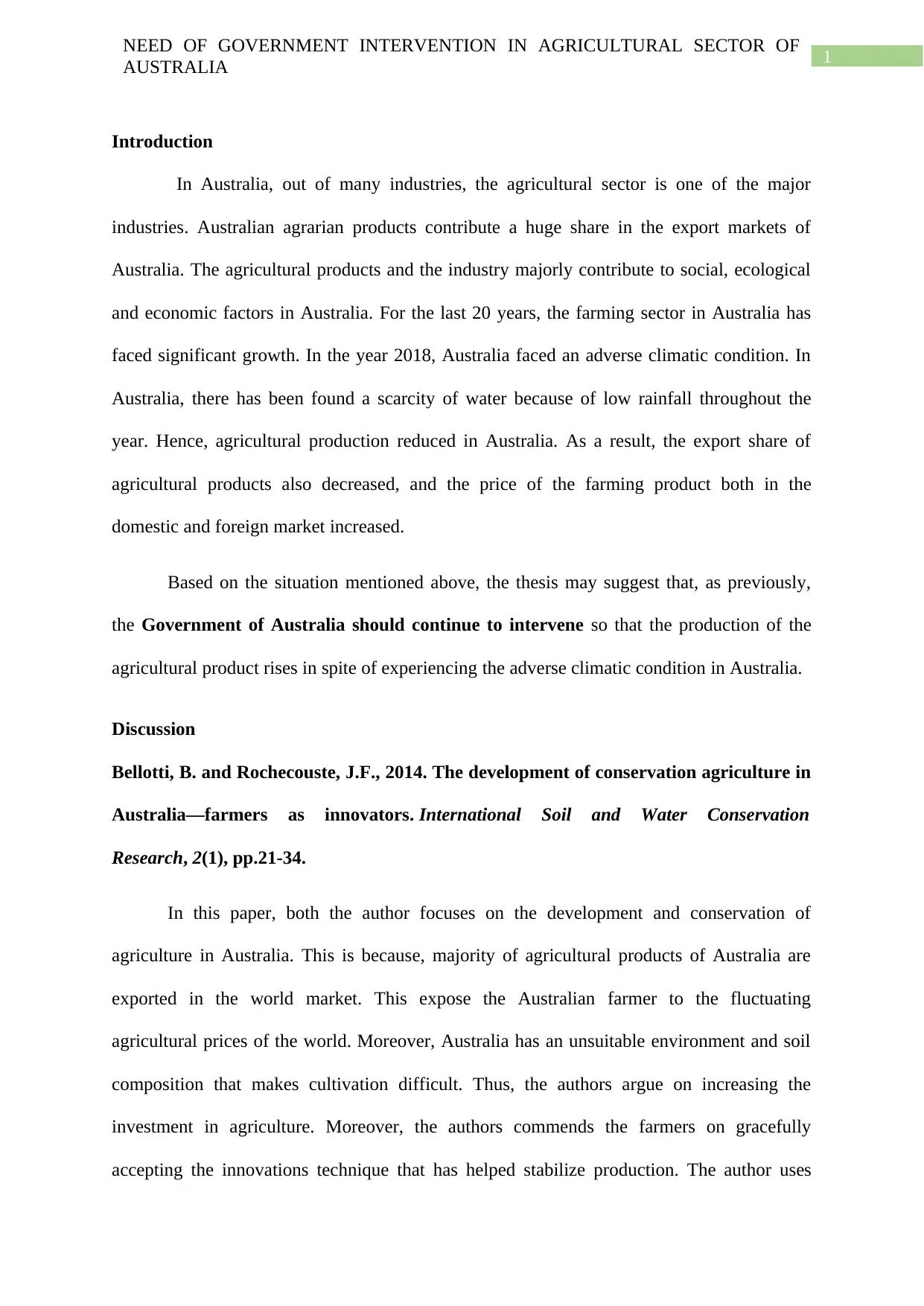
1
NEED OF GOVERNMENT INTERVENTION IN AGRICULTURAL SECTOR OF
AUSTRALIA
Introduction
In Australia, out of many industries, the agricultural sector is one of the major
industries. Australian agrarian products contribute a huge share in the export markets of
Australia. The agricultural products and the industry majorly contribute to social, ecological
and economic factors in Australia. For the last 20 years, the farming sector in Australia has
faced significant growth. In the year 2018, Australia faced an adverse climatic condition. In
Australia, there has been found a scarcity of water because of low rainfall throughout the
year. Hence, agricultural production reduced in Australia. As a result, the export share of
agricultural products also decreased, and the price of the farming product both in the
domestic and foreign market increased.
Based on the situation mentioned above, the thesis may suggest that, as previously,
the Government of Australia should continue to intervene so that the production of the
agricultural product rises in spite of experiencing the adverse climatic condition in Australia.
Discussion
Bellotti, B. and Rochecouste, J.F., 2014. The development of conservation agriculture in
Australia—farmers as innovators. International Soil and Water Conservation
Research, 2(1), pp.21-34.
In this paper, both the author focuses on the development and conservation of
agriculture in Australia. This is because, majority of agricultural products of Australia are
exported in the world market. This expose the Australian farmer to the fluctuating
agricultural prices of the world. Moreover, Australia has an unsuitable environment and soil
composition that makes cultivation difficult. Thus, the authors argue on increasing the
investment in agriculture. Moreover, the authors commends the farmers on gracefully
accepting the innovations technique that has helped stabilize production. The author uses
NEED OF GOVERNMENT INTERVENTION IN AGRICULTURAL SECTOR OF
AUSTRALIA
Introduction
In Australia, out of many industries, the agricultural sector is one of the major
industries. Australian agrarian products contribute a huge share in the export markets of
Australia. The agricultural products and the industry majorly contribute to social, ecological
and economic factors in Australia. For the last 20 years, the farming sector in Australia has
faced significant growth. In the year 2018, Australia faced an adverse climatic condition. In
Australia, there has been found a scarcity of water because of low rainfall throughout the
year. Hence, agricultural production reduced in Australia. As a result, the export share of
agricultural products also decreased, and the price of the farming product both in the
domestic and foreign market increased.
Based on the situation mentioned above, the thesis may suggest that, as previously,
the Government of Australia should continue to intervene so that the production of the
agricultural product rises in spite of experiencing the adverse climatic condition in Australia.
Discussion
Bellotti, B. and Rochecouste, J.F., 2014. The development of conservation agriculture in
Australia—farmers as innovators. International Soil and Water Conservation
Research, 2(1), pp.21-34.
In this paper, both the author focuses on the development and conservation of
agriculture in Australia. This is because, majority of agricultural products of Australia are
exported in the world market. This expose the Australian farmer to the fluctuating
agricultural prices of the world. Moreover, Australia has an unsuitable environment and soil
composition that makes cultivation difficult. Thus, the authors argue on increasing the
investment in agriculture. Moreover, the authors commends the farmers on gracefully
accepting the innovations technique that has helped stabilize production. The author uses
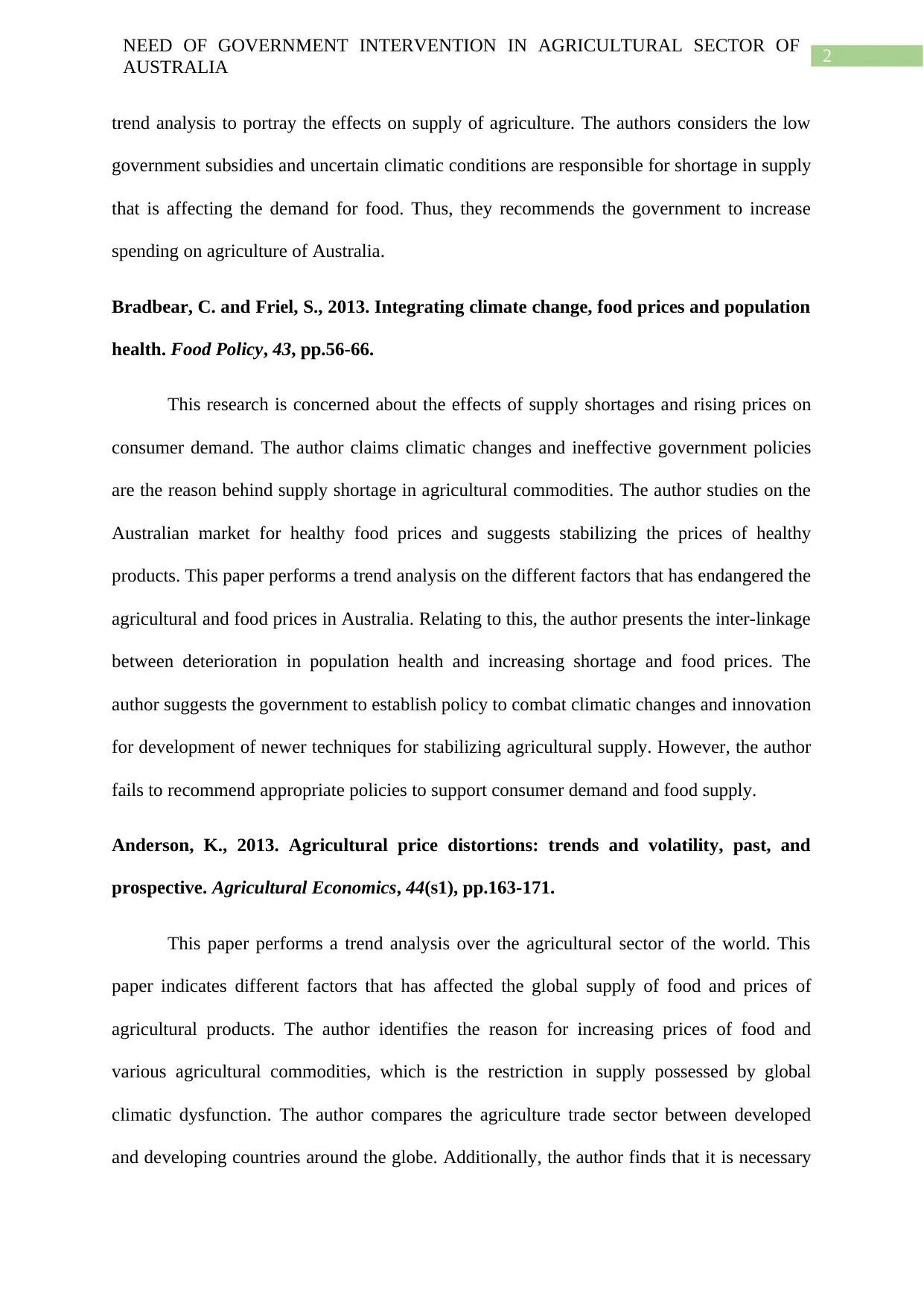
2
NEED OF GOVERNMENT INTERVENTION IN AGRICULTURAL SECTOR OF
AUSTRALIA
trend analysis to portray the effects on supply of agriculture. The authors considers the low
government subsidies and uncertain climatic conditions are responsible for shortage in supply
that is affecting the demand for food. Thus, they recommends the government to increase
spending on agriculture of Australia.
Bradbear, C. and Friel, S., 2013. Integrating climate change, food prices and population
health. Food Policy, 43, pp.56-66.
This research is concerned about the effects of supply shortages and rising prices on
consumer demand. The author claims climatic changes and ineffective government policies
are the reason behind supply shortage in agricultural commodities. The author studies on the
Australian market for healthy food prices and suggests stabilizing the prices of healthy
products. This paper performs a trend analysis on the different factors that has endangered the
agricultural and food prices in Australia. Relating to this, the author presents the inter-linkage
between deterioration in population health and increasing shortage and food prices. The
author suggests the government to establish policy to combat climatic changes and innovation
for development of newer techniques for stabilizing agricultural supply. However, the author
fails to recommend appropriate policies to support consumer demand and food supply.
Anderson, K., 2013. Agricultural price distortions: trends and volatility, past, and
prospective. Agricultural Economics, 44(s1), pp.163-171.
This paper performs a trend analysis over the agricultural sector of the world. This
paper indicates different factors that has affected the global supply of food and prices of
agricultural products. The author identifies the reason for increasing prices of food and
various agricultural commodities, which is the restriction in supply possessed by global
climatic dysfunction. The author compares the agriculture trade sector between developed
and developing countries around the globe. Additionally, the author finds that it is necessary
NEED OF GOVERNMENT INTERVENTION IN AGRICULTURAL SECTOR OF
AUSTRALIA
trend analysis to portray the effects on supply of agriculture. The authors considers the low
government subsidies and uncertain climatic conditions are responsible for shortage in supply
that is affecting the demand for food. Thus, they recommends the government to increase
spending on agriculture of Australia.
Bradbear, C. and Friel, S., 2013. Integrating climate change, food prices and population
health. Food Policy, 43, pp.56-66.
This research is concerned about the effects of supply shortages and rising prices on
consumer demand. The author claims climatic changes and ineffective government policies
are the reason behind supply shortage in agricultural commodities. The author studies on the
Australian market for healthy food prices and suggests stabilizing the prices of healthy
products. This paper performs a trend analysis on the different factors that has endangered the
agricultural and food prices in Australia. Relating to this, the author presents the inter-linkage
between deterioration in population health and increasing shortage and food prices. The
author suggests the government to establish policy to combat climatic changes and innovation
for development of newer techniques for stabilizing agricultural supply. However, the author
fails to recommend appropriate policies to support consumer demand and food supply.
Anderson, K., 2013. Agricultural price distortions: trends and volatility, past, and
prospective. Agricultural Economics, 44(s1), pp.163-171.
This paper performs a trend analysis over the agricultural sector of the world. This
paper indicates different factors that has affected the global supply of food and prices of
agricultural products. The author identifies the reason for increasing prices of food and
various agricultural commodities, which is the restriction in supply possessed by global
climatic dysfunction. The author compares the agriculture trade sector between developed
and developing countries around the globe. Additionally, the author finds that it is necessary
⊘ This is a preview!⊘
Do you want full access?
Subscribe today to unlock all pages.

Trusted by 1+ million students worldwide
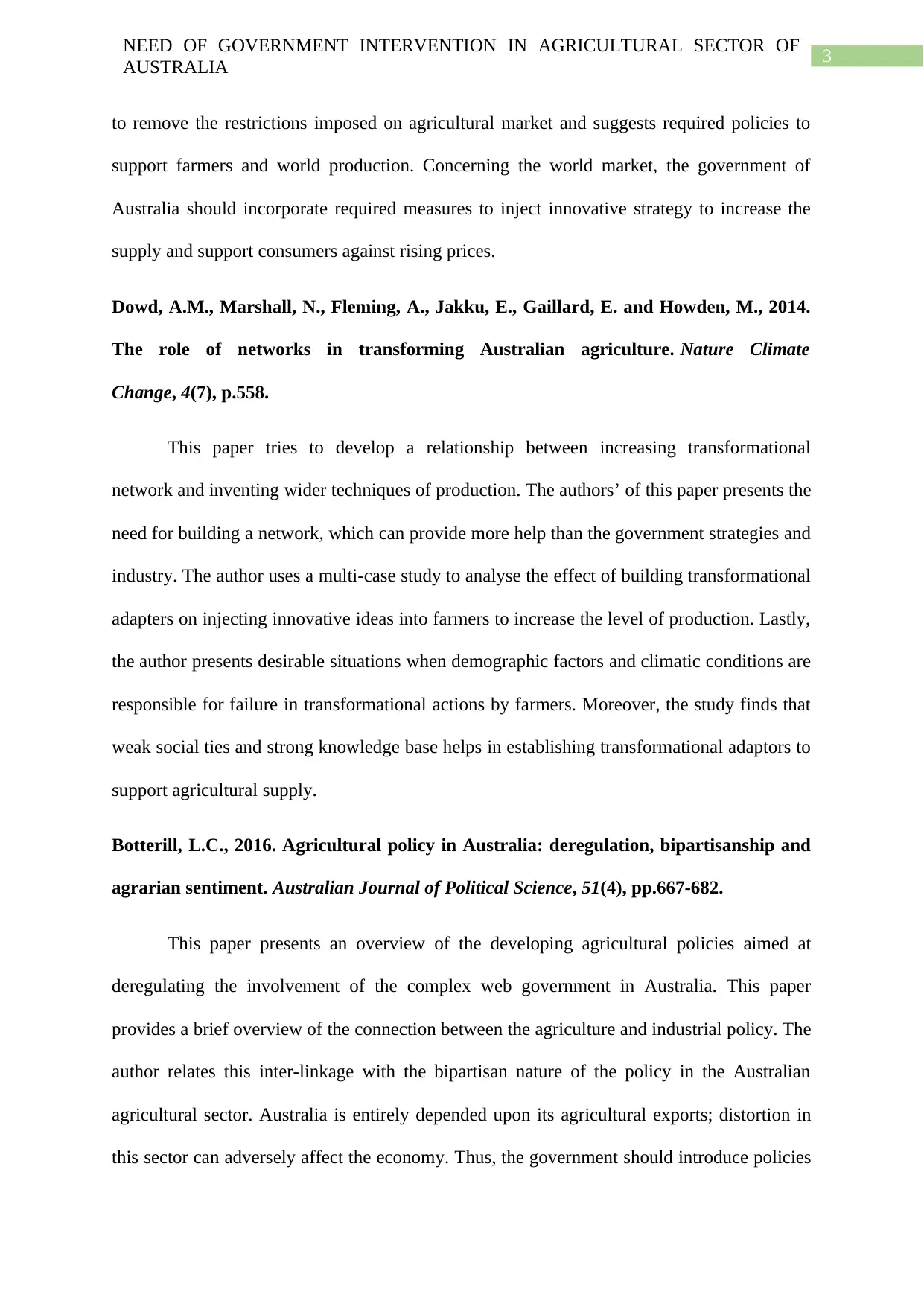
3
NEED OF GOVERNMENT INTERVENTION IN AGRICULTURAL SECTOR OF
AUSTRALIA
to remove the restrictions imposed on agricultural market and suggests required policies to
support farmers and world production. Concerning the world market, the government of
Australia should incorporate required measures to inject innovative strategy to increase the
supply and support consumers against rising prices.
Dowd, A.M., Marshall, N., Fleming, A., Jakku, E., Gaillard, E. and Howden, M., 2014.
The role of networks in transforming Australian agriculture. Nature Climate
Change, 4(7), p.558.
This paper tries to develop a relationship between increasing transformational
network and inventing wider techniques of production. The authors’ of this paper presents the
need for building a network, which can provide more help than the government strategies and
industry. The author uses a multi-case study to analyse the effect of building transformational
adapters on injecting innovative ideas into farmers to increase the level of production. Lastly,
the author presents desirable situations when demographic factors and climatic conditions are
responsible for failure in transformational actions by farmers. Moreover, the study finds that
weak social ties and strong knowledge base helps in establishing transformational adaptors to
support agricultural supply.
Botterill, L.C., 2016. Agricultural policy in Australia: deregulation, bipartisanship and
agrarian sentiment. Australian Journal of Political Science, 51(4), pp.667-682.
This paper presents an overview of the developing agricultural policies aimed at
deregulating the involvement of the complex web government in Australia. This paper
provides a brief overview of the connection between the agriculture and industrial policy. The
author relates this inter-linkage with the bipartisan nature of the policy in the Australian
agricultural sector. Australia is entirely depended upon its agricultural exports; distortion in
this sector can adversely affect the economy. Thus, the government should introduce policies
NEED OF GOVERNMENT INTERVENTION IN AGRICULTURAL SECTOR OF
AUSTRALIA
to remove the restrictions imposed on agricultural market and suggests required policies to
support farmers and world production. Concerning the world market, the government of
Australia should incorporate required measures to inject innovative strategy to increase the
supply and support consumers against rising prices.
Dowd, A.M., Marshall, N., Fleming, A., Jakku, E., Gaillard, E. and Howden, M., 2014.
The role of networks in transforming Australian agriculture. Nature Climate
Change, 4(7), p.558.
This paper tries to develop a relationship between increasing transformational
network and inventing wider techniques of production. The authors’ of this paper presents the
need for building a network, which can provide more help than the government strategies and
industry. The author uses a multi-case study to analyse the effect of building transformational
adapters on injecting innovative ideas into farmers to increase the level of production. Lastly,
the author presents desirable situations when demographic factors and climatic conditions are
responsible for failure in transformational actions by farmers. Moreover, the study finds that
weak social ties and strong knowledge base helps in establishing transformational adaptors to
support agricultural supply.
Botterill, L.C., 2016. Agricultural policy in Australia: deregulation, bipartisanship and
agrarian sentiment. Australian Journal of Political Science, 51(4), pp.667-682.
This paper presents an overview of the developing agricultural policies aimed at
deregulating the involvement of the complex web government in Australia. This paper
provides a brief overview of the connection between the agriculture and industrial policy. The
author relates this inter-linkage with the bipartisan nature of the policy in the Australian
agricultural sector. Australia is entirely depended upon its agricultural exports; distortion in
this sector can adversely affect the economy. Thus, the government should introduce policies
Paraphrase This Document
Need a fresh take? Get an instant paraphrase of this document with our AI Paraphraser
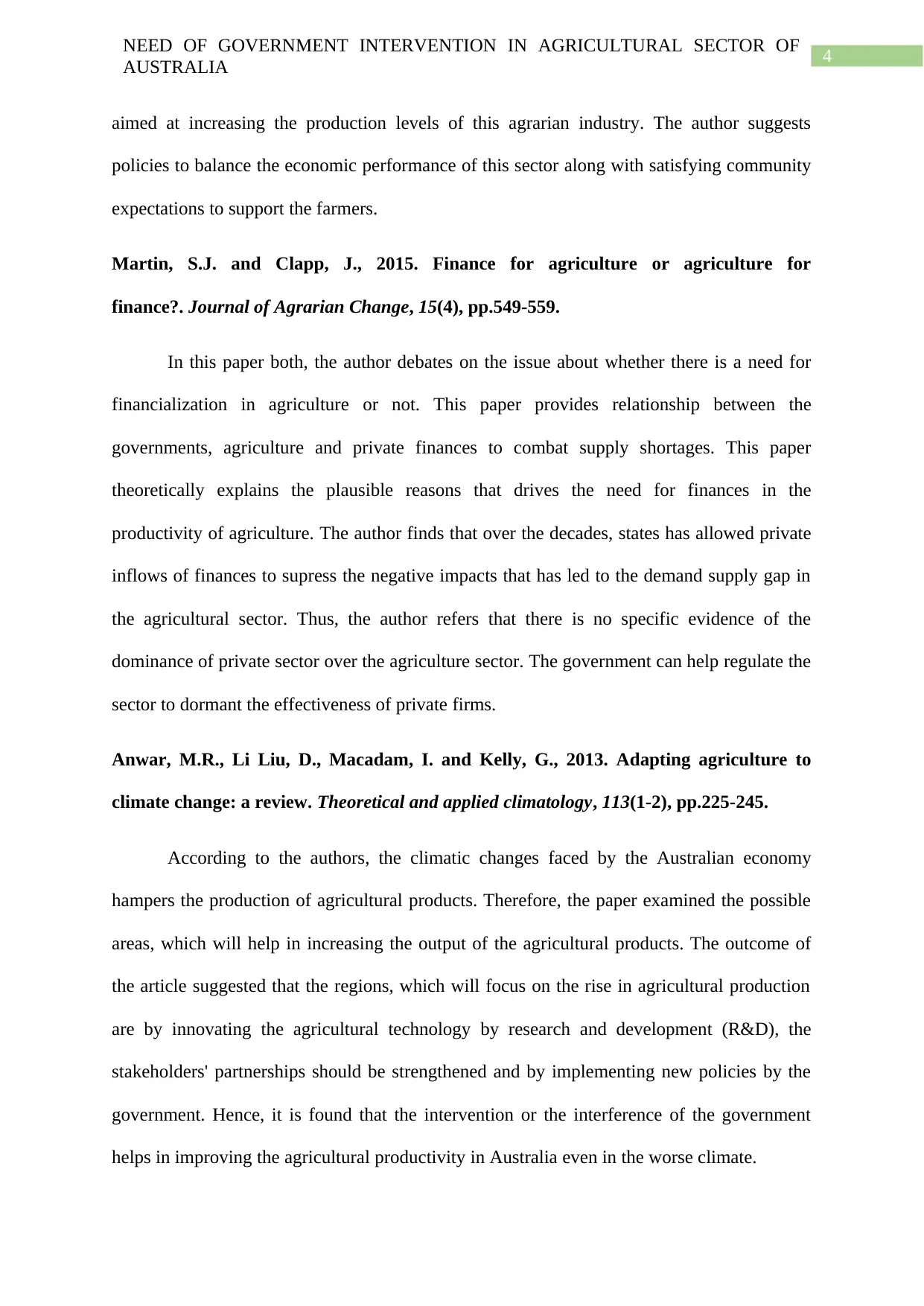
4
NEED OF GOVERNMENT INTERVENTION IN AGRICULTURAL SECTOR OF
AUSTRALIA
aimed at increasing the production levels of this agrarian industry. The author suggests
policies to balance the economic performance of this sector along with satisfying community
expectations to support the farmers.
Martin, S.J. and Clapp, J., 2015. Finance for agriculture or agriculture for
finance?. Journal of Agrarian Change, 15(4), pp.549-559.
In this paper both, the author debates on the issue about whether there is a need for
financialization in agriculture or not. This paper provides relationship between the
governments, agriculture and private finances to combat supply shortages. This paper
theoretically explains the plausible reasons that drives the need for finances in the
productivity of agriculture. The author finds that over the decades, states has allowed private
inflows of finances to supress the negative impacts that has led to the demand supply gap in
the agricultural sector. Thus, the author refers that there is no specific evidence of the
dominance of private sector over the agriculture sector. The government can help regulate the
sector to dormant the effectiveness of private firms.
Anwar, M.R., Li Liu, D., Macadam, I. and Kelly, G., 2013. Adapting agriculture to
climate change: a review. Theoretical and applied climatology, 113(1-2), pp.225-245.
According to the authors, the climatic changes faced by the Australian economy
hampers the production of agricultural products. Therefore, the paper examined the possible
areas, which will help in increasing the output of the agricultural products. The outcome of
the article suggested that the regions, which will focus on the rise in agricultural production
are by innovating the agricultural technology by research and development (R&D), the
stakeholders' partnerships should be strengthened and by implementing new policies by the
government. Hence, it is found that the intervention or the interference of the government
helps in improving the agricultural productivity in Australia even in the worse climate.
NEED OF GOVERNMENT INTERVENTION IN AGRICULTURAL SECTOR OF
AUSTRALIA
aimed at increasing the production levels of this agrarian industry. The author suggests
policies to balance the economic performance of this sector along with satisfying community
expectations to support the farmers.
Martin, S.J. and Clapp, J., 2015. Finance for agriculture or agriculture for
finance?. Journal of Agrarian Change, 15(4), pp.549-559.
In this paper both, the author debates on the issue about whether there is a need for
financialization in agriculture or not. This paper provides relationship between the
governments, agriculture and private finances to combat supply shortages. This paper
theoretically explains the plausible reasons that drives the need for finances in the
productivity of agriculture. The author finds that over the decades, states has allowed private
inflows of finances to supress the negative impacts that has led to the demand supply gap in
the agricultural sector. Thus, the author refers that there is no specific evidence of the
dominance of private sector over the agriculture sector. The government can help regulate the
sector to dormant the effectiveness of private firms.
Anwar, M.R., Li Liu, D., Macadam, I. and Kelly, G., 2013. Adapting agriculture to
climate change: a review. Theoretical and applied climatology, 113(1-2), pp.225-245.
According to the authors, the climatic changes faced by the Australian economy
hampers the production of agricultural products. Therefore, the paper examined the possible
areas, which will help in increasing the output of the agricultural products. The outcome of
the article suggested that the regions, which will focus on the rise in agricultural production
are by innovating the agricultural technology by research and development (R&D), the
stakeholders' partnerships should be strengthened and by implementing new policies by the
government. Hence, it is found that the intervention or the interference of the government
helps in improving the agricultural productivity in Australia even in the worse climate.
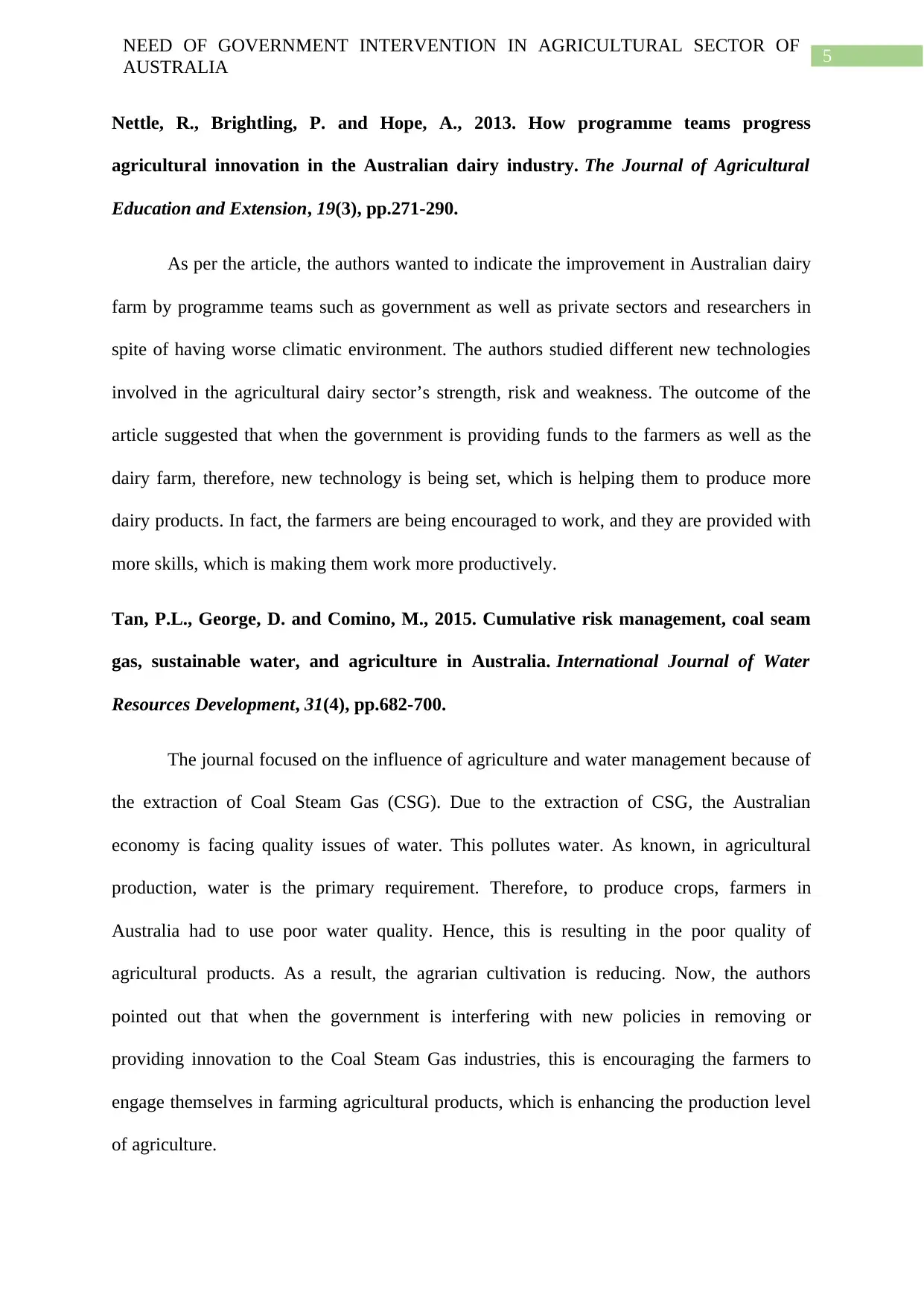
5
NEED OF GOVERNMENT INTERVENTION IN AGRICULTURAL SECTOR OF
AUSTRALIA
Nettle, R., Brightling, P. and Hope, A., 2013. How programme teams progress
agricultural innovation in the Australian dairy industry. The Journal of Agricultural
Education and Extension, 19(3), pp.271-290.
As per the article, the authors wanted to indicate the improvement in Australian dairy
farm by programme teams such as government as well as private sectors and researchers in
spite of having worse climatic environment. The authors studied different new technologies
involved in the agricultural dairy sector’s strength, risk and weakness. The outcome of the
article suggested that when the government is providing funds to the farmers as well as the
dairy farm, therefore, new technology is being set, which is helping them to produce more
dairy products. In fact, the farmers are being encouraged to work, and they are provided with
more skills, which is making them work more productively.
Tan, P.L., George, D. and Comino, M., 2015. Cumulative risk management, coal seam
gas, sustainable water, and agriculture in Australia. International Journal of Water
Resources Development, 31(4), pp.682-700.
The journal focused on the influence of agriculture and water management because of
the extraction of Coal Steam Gas (CSG). Due to the extraction of CSG, the Australian
economy is facing quality issues of water. This pollutes water. As known, in agricultural
production, water is the primary requirement. Therefore, to produce crops, farmers in
Australia had to use poor water quality. Hence, this is resulting in the poor quality of
agricultural products. As a result, the agrarian cultivation is reducing. Now, the authors
pointed out that when the government is interfering with new policies in removing or
providing innovation to the Coal Steam Gas industries, this is encouraging the farmers to
engage themselves in farming agricultural products, which is enhancing the production level
of agriculture.
NEED OF GOVERNMENT INTERVENTION IN AGRICULTURAL SECTOR OF
AUSTRALIA
Nettle, R., Brightling, P. and Hope, A., 2013. How programme teams progress
agricultural innovation in the Australian dairy industry. The Journal of Agricultural
Education and Extension, 19(3), pp.271-290.
As per the article, the authors wanted to indicate the improvement in Australian dairy
farm by programme teams such as government as well as private sectors and researchers in
spite of having worse climatic environment. The authors studied different new technologies
involved in the agricultural dairy sector’s strength, risk and weakness. The outcome of the
article suggested that when the government is providing funds to the farmers as well as the
dairy farm, therefore, new technology is being set, which is helping them to produce more
dairy products. In fact, the farmers are being encouraged to work, and they are provided with
more skills, which is making them work more productively.
Tan, P.L., George, D. and Comino, M., 2015. Cumulative risk management, coal seam
gas, sustainable water, and agriculture in Australia. International Journal of Water
Resources Development, 31(4), pp.682-700.
The journal focused on the influence of agriculture and water management because of
the extraction of Coal Steam Gas (CSG). Due to the extraction of CSG, the Australian
economy is facing quality issues of water. This pollutes water. As known, in agricultural
production, water is the primary requirement. Therefore, to produce crops, farmers in
Australia had to use poor water quality. Hence, this is resulting in the poor quality of
agricultural products. As a result, the agrarian cultivation is reducing. Now, the authors
pointed out that when the government is interfering with new policies in removing or
providing innovation to the Coal Steam Gas industries, this is encouraging the farmers to
engage themselves in farming agricultural products, which is enhancing the production level
of agriculture.
⊘ This is a preview!⊘
Do you want full access?
Subscribe today to unlock all pages.

Trusted by 1+ million students worldwide
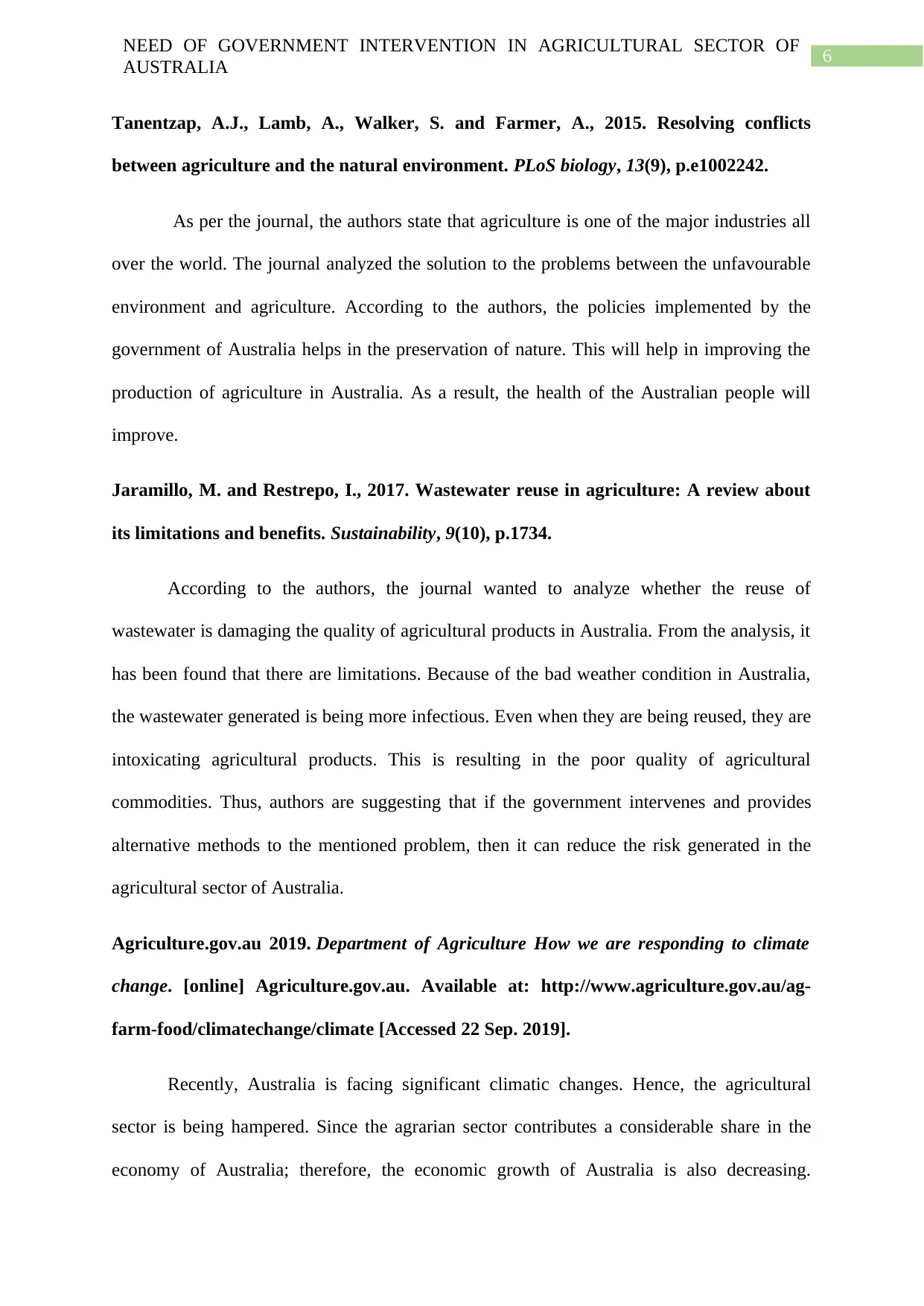
6
NEED OF GOVERNMENT INTERVENTION IN AGRICULTURAL SECTOR OF
AUSTRALIA
Tanentzap, A.J., Lamb, A., Walker, S. and Farmer, A., 2015. Resolving conflicts
between agriculture and the natural environment. PLoS biology, 13(9), p.e1002242.
As per the journal, the authors state that agriculture is one of the major industries all
over the world. The journal analyzed the solution to the problems between the unfavourable
environment and agriculture. According to the authors, the policies implemented by the
government of Australia helps in the preservation of nature. This will help in improving the
production of agriculture in Australia. As a result, the health of the Australian people will
improve.
Jaramillo, M. and Restrepo, I., 2017. Wastewater reuse in agriculture: A review about
its limitations and benefits. Sustainability, 9(10), p.1734.
According to the authors, the journal wanted to analyze whether the reuse of
wastewater is damaging the quality of agricultural products in Australia. From the analysis, it
has been found that there are limitations. Because of the bad weather condition in Australia,
the wastewater generated is being more infectious. Even when they are being reused, they are
intoxicating agricultural products. This is resulting in the poor quality of agricultural
commodities. Thus, authors are suggesting that if the government intervenes and provides
alternative methods to the mentioned problem, then it can reduce the risk generated in the
agricultural sector of Australia.
Agriculture.gov.au 2019. Department of Agriculture How we are responding to climate
change. [online] Agriculture.gov.au. Available at: http://www.agriculture.gov.au/ag-
farm-food/climatechange/climate [Accessed 22 Sep. 2019].
Recently, Australia is facing significant climatic changes. Hence, the agricultural
sector is being hampered. Since the agrarian sector contributes a considerable share in the
economy of Australia; therefore, the economic growth of Australia is also decreasing.
NEED OF GOVERNMENT INTERVENTION IN AGRICULTURAL SECTOR OF
AUSTRALIA
Tanentzap, A.J., Lamb, A., Walker, S. and Farmer, A., 2015. Resolving conflicts
between agriculture and the natural environment. PLoS biology, 13(9), p.e1002242.
As per the journal, the authors state that agriculture is one of the major industries all
over the world. The journal analyzed the solution to the problems between the unfavourable
environment and agriculture. According to the authors, the policies implemented by the
government of Australia helps in the preservation of nature. This will help in improving the
production of agriculture in Australia. As a result, the health of the Australian people will
improve.
Jaramillo, M. and Restrepo, I., 2017. Wastewater reuse in agriculture: A review about
its limitations and benefits. Sustainability, 9(10), p.1734.
According to the authors, the journal wanted to analyze whether the reuse of
wastewater is damaging the quality of agricultural products in Australia. From the analysis, it
has been found that there are limitations. Because of the bad weather condition in Australia,
the wastewater generated is being more infectious. Even when they are being reused, they are
intoxicating agricultural products. This is resulting in the poor quality of agricultural
commodities. Thus, authors are suggesting that if the government intervenes and provides
alternative methods to the mentioned problem, then it can reduce the risk generated in the
agricultural sector of Australia.
Agriculture.gov.au 2019. Department of Agriculture How we are responding to climate
change. [online] Agriculture.gov.au. Available at: http://www.agriculture.gov.au/ag-
farm-food/climatechange/climate [Accessed 22 Sep. 2019].
Recently, Australia is facing significant climatic changes. Hence, the agricultural
sector is being hampered. Since the agrarian sector contributes a considerable share in the
economy of Australia; therefore, the economic growth of Australia is also decreasing.
Paraphrase This Document
Need a fresh take? Get an instant paraphrase of this document with our AI Paraphraser
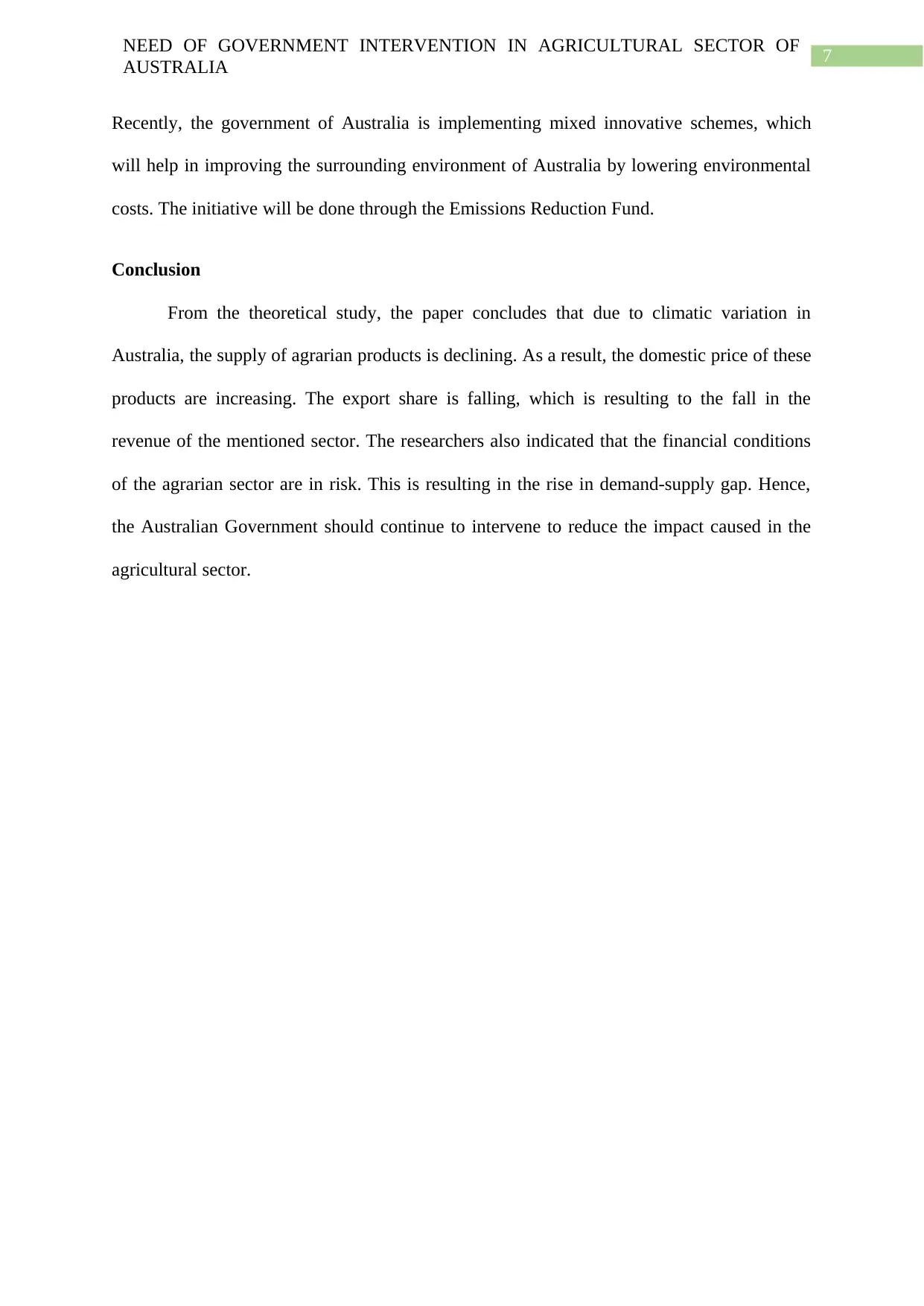
7
NEED OF GOVERNMENT INTERVENTION IN AGRICULTURAL SECTOR OF
AUSTRALIA
Recently, the government of Australia is implementing mixed innovative schemes, which
will help in improving the surrounding environment of Australia by lowering environmental
costs. The initiative will be done through the Emissions Reduction Fund.
Conclusion
From the theoretical study, the paper concludes that due to climatic variation in
Australia, the supply of agrarian products is declining. As a result, the domestic price of these
products are increasing. The export share is falling, which is resulting to the fall in the
revenue of the mentioned sector. The researchers also indicated that the financial conditions
of the agrarian sector are in risk. This is resulting in the rise in demand-supply gap. Hence,
the Australian Government should continue to intervene to reduce the impact caused in the
agricultural sector.
NEED OF GOVERNMENT INTERVENTION IN AGRICULTURAL SECTOR OF
AUSTRALIA
Recently, the government of Australia is implementing mixed innovative schemes, which
will help in improving the surrounding environment of Australia by lowering environmental
costs. The initiative will be done through the Emissions Reduction Fund.
Conclusion
From the theoretical study, the paper concludes that due to climatic variation in
Australia, the supply of agrarian products is declining. As a result, the domestic price of these
products are increasing. The export share is falling, which is resulting to the fall in the
revenue of the mentioned sector. The researchers also indicated that the financial conditions
of the agrarian sector are in risk. This is resulting in the rise in demand-supply gap. Hence,
the Australian Government should continue to intervene to reduce the impact caused in the
agricultural sector.
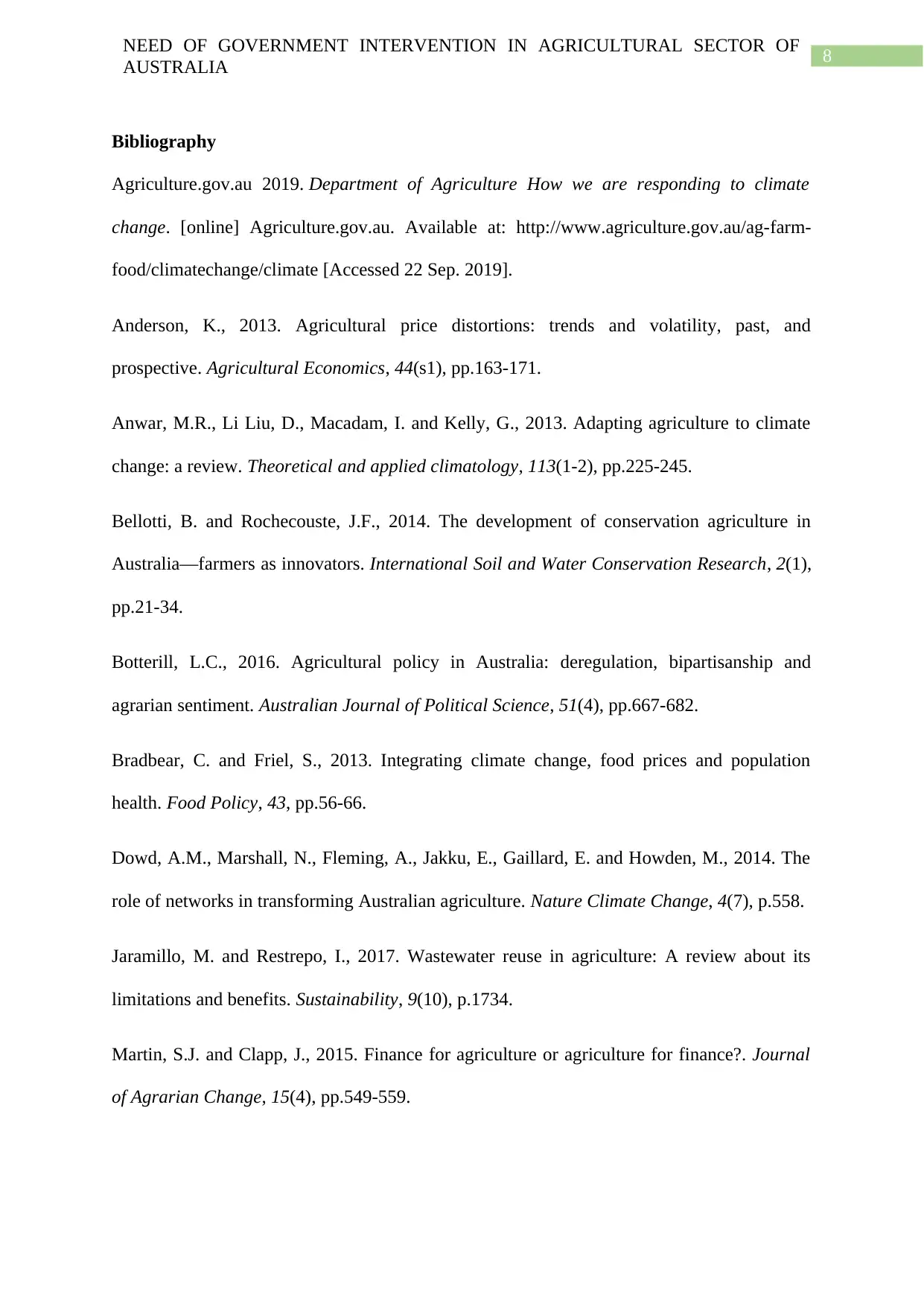
8
NEED OF GOVERNMENT INTERVENTION IN AGRICULTURAL SECTOR OF
AUSTRALIA
Bibliography
Agriculture.gov.au 2019. Department of Agriculture How we are responding to climate
change. [online] Agriculture.gov.au. Available at: http://www.agriculture.gov.au/ag-farm-
food/climatechange/climate [Accessed 22 Sep. 2019].
Anderson, K., 2013. Agricultural price distortions: trends and volatility, past, and
prospective. Agricultural Economics, 44(s1), pp.163-171.
Anwar, M.R., Li Liu, D., Macadam, I. and Kelly, G., 2013. Adapting agriculture to climate
change: a review. Theoretical and applied climatology, 113(1-2), pp.225-245.
Bellotti, B. and Rochecouste, J.F., 2014. The development of conservation agriculture in
Australia—farmers as innovators. International Soil and Water Conservation Research, 2(1),
pp.21-34.
Botterill, L.C., 2016. Agricultural policy in Australia: deregulation, bipartisanship and
agrarian sentiment. Australian Journal of Political Science, 51(4), pp.667-682.
Bradbear, C. and Friel, S., 2013. Integrating climate change, food prices and population
health. Food Policy, 43, pp.56-66.
Dowd, A.M., Marshall, N., Fleming, A., Jakku, E., Gaillard, E. and Howden, M., 2014. The
role of networks in transforming Australian agriculture. Nature Climate Change, 4(7), p.558.
Jaramillo, M. and Restrepo, I., 2017. Wastewater reuse in agriculture: A review about its
limitations and benefits. Sustainability, 9(10), p.1734.
Martin, S.J. and Clapp, J., 2015. Finance for agriculture or agriculture for finance?. Journal
of Agrarian Change, 15(4), pp.549-559.
NEED OF GOVERNMENT INTERVENTION IN AGRICULTURAL SECTOR OF
AUSTRALIA
Bibliography
Agriculture.gov.au 2019. Department of Agriculture How we are responding to climate
change. [online] Agriculture.gov.au. Available at: http://www.agriculture.gov.au/ag-farm-
food/climatechange/climate [Accessed 22 Sep. 2019].
Anderson, K., 2013. Agricultural price distortions: trends and volatility, past, and
prospective. Agricultural Economics, 44(s1), pp.163-171.
Anwar, M.R., Li Liu, D., Macadam, I. and Kelly, G., 2013. Adapting agriculture to climate
change: a review. Theoretical and applied climatology, 113(1-2), pp.225-245.
Bellotti, B. and Rochecouste, J.F., 2014. The development of conservation agriculture in
Australia—farmers as innovators. International Soil and Water Conservation Research, 2(1),
pp.21-34.
Botterill, L.C., 2016. Agricultural policy in Australia: deregulation, bipartisanship and
agrarian sentiment. Australian Journal of Political Science, 51(4), pp.667-682.
Bradbear, C. and Friel, S., 2013. Integrating climate change, food prices and population
health. Food Policy, 43, pp.56-66.
Dowd, A.M., Marshall, N., Fleming, A., Jakku, E., Gaillard, E. and Howden, M., 2014. The
role of networks in transforming Australian agriculture. Nature Climate Change, 4(7), p.558.
Jaramillo, M. and Restrepo, I., 2017. Wastewater reuse in agriculture: A review about its
limitations and benefits. Sustainability, 9(10), p.1734.
Martin, S.J. and Clapp, J., 2015. Finance for agriculture or agriculture for finance?. Journal
of Agrarian Change, 15(4), pp.549-559.
⊘ This is a preview!⊘
Do you want full access?
Subscribe today to unlock all pages.

Trusted by 1+ million students worldwide
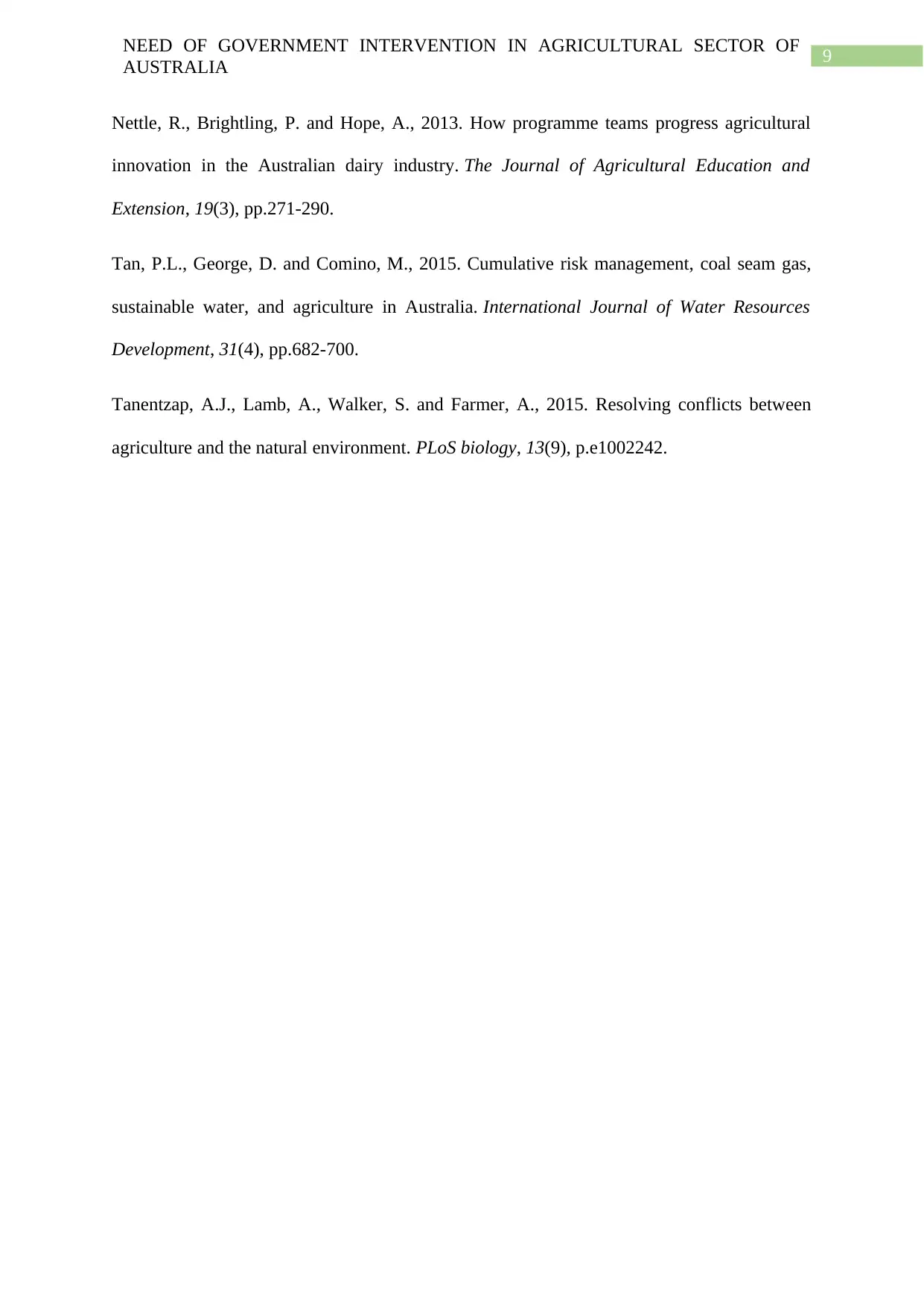
9
NEED OF GOVERNMENT INTERVENTION IN AGRICULTURAL SECTOR OF
AUSTRALIA
Nettle, R., Brightling, P. and Hope, A., 2013. How programme teams progress agricultural
innovation in the Australian dairy industry. The Journal of Agricultural Education and
Extension, 19(3), pp.271-290.
Tan, P.L., George, D. and Comino, M., 2015. Cumulative risk management, coal seam gas,
sustainable water, and agriculture in Australia. International Journal of Water Resources
Development, 31(4), pp.682-700.
Tanentzap, A.J., Lamb, A., Walker, S. and Farmer, A., 2015. Resolving conflicts between
agriculture and the natural environment. PLoS biology, 13(9), p.e1002242.
NEED OF GOVERNMENT INTERVENTION IN AGRICULTURAL SECTOR OF
AUSTRALIA
Nettle, R., Brightling, P. and Hope, A., 2013. How programme teams progress agricultural
innovation in the Australian dairy industry. The Journal of Agricultural Education and
Extension, 19(3), pp.271-290.
Tan, P.L., George, D. and Comino, M., 2015. Cumulative risk management, coal seam gas,
sustainable water, and agriculture in Australia. International Journal of Water Resources
Development, 31(4), pp.682-700.
Tanentzap, A.J., Lamb, A., Walker, S. and Farmer, A., 2015. Resolving conflicts between
agriculture and the natural environment. PLoS biology, 13(9), p.e1002242.
1 out of 10
Related Documents
Your All-in-One AI-Powered Toolkit for Academic Success.
+13062052269
info@desklib.com
Available 24*7 on WhatsApp / Email
![[object Object]](/_next/static/media/star-bottom.7253800d.svg)
Unlock your academic potential
Copyright © 2020–2025 A2Z Services. All Rights Reserved. Developed and managed by ZUCOL.





